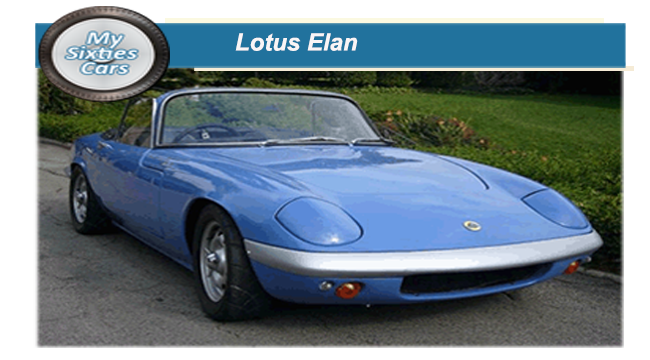
The Lotus Elan made its debut in 1962, replacing the expensive-to-build and now cumbersome looking Elite.
An uncompromising manifestation of Colin Chapman's weight design philosophy and delivered acceleration and top speed ahead of its time for this class of sports car, the Elan was powered by a 1498cc evolution version of the sturdy Ford Kent engine matched up to a four-speed gearbox from Ford.
With a Lotus-designed Cosworth twin-cam alloy head, this was the same winning combination that had been fitted in the punchy Mark I Lotus Cortina.
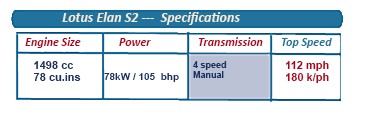 Thanks to its lightweight steel chassis and fibreglass body that dramatically reduced weight, the Elan could reach a top speed of 120 mph (190 km/h) and go from 0–60 mph in just 7.9 seconds, and generate 105bhp engine had twin chain-driven cams.
Thanks to its lightweight steel chassis and fibreglass body that dramatically reduced weight, the Elan could reach a top speed of 120 mph (190 km/h) and go from 0–60 mph in just 7.9 seconds, and generate 105bhp engine had twin chain-driven cams.
The Lotus Elan was among the first road cars to be fitted with independent pension and disc brakes all round long before these became widely standard features.
With its s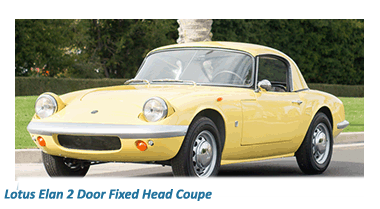 treamlined shape and pop-up headlamps, the Elan roadster was an instant hit.
treamlined shape and pop-up headlamps, the Elan roadster was an instant hit.
One of Colin Chapman's greatest regrets with the Elite was, as the roof panel was a part of he body frame. a roadster could not possibly have been produced.
Learning from his mistake, Chapman made sure that with the Elan, a new form of construction, would be adopted, based around a fabricated steel backbone chassis, forking at front and rear to accept the engine and suspensions and allowing for the production of a convertible version.
![]()
Following the successful launch of the two-seater roadster, a hardtop version was not long in coming, its arrival announced in September 1965.
The Lotus Elan fixed-head coupe was similar to the convertible hard-top but with slightly more attractive lines, rearward-extended boot-lid, boot-mounted battery, electrically wound windows and greater refinement than any model released by Lotus to date.
Despite it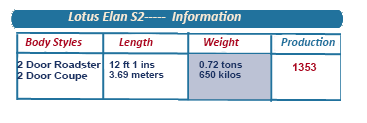 s added weight and firmer ride, the + 2 was still an exhilarating car to drive, and better aerodynamics served to reduce wind noise at high speed.
s added weight and firmer ride, the + 2 was still an exhilarating car to drive, and better aerodynamics served to reduce wind noise at high speed.
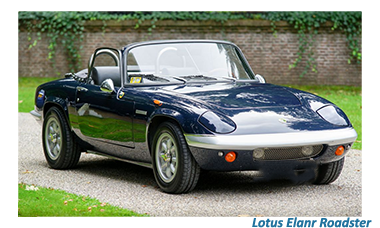 This improvement was at the expense of only slightly slower acceleration.
This improvement was at the expense of only slightly slower acceleration.
The overall the finish of the + 2 was much better than its predecessor and, indeed, this was the first Lotus to be offered as a complete car, as well as being available in kit form for those who still preferred to bond with their vehicles from birth.
The new coupe shape contributed to improved performance, although the extra ten bhp must also have helped somewhere.
Top speed was now about 123 mph, while 0-50 mph times - even with the standard Ford gearbox ratios - were down to 6 seconds, matching the performance of an E-Type Jaguar.
Despite the performance, the Elan's fuel economy remained impressive.
![]()
With the SE, extras included stiffer rear dampers to provide greater high-speed stability, and although this hardened the ride, it was still very comfortable considering the enormous cornering power of the car.
Cross-coun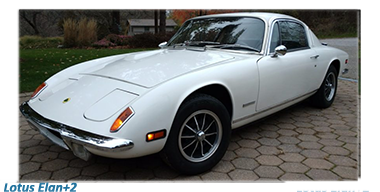 try journeys could be accomplished at very high average speeds in great safety and with a minimum of duscomfort for driver and passenger.
try journeys could be accomplished at very high average speeds in great safety and with a minimum of duscomfort for driver and passenger.
Although 580mm (23in) longer and 190mm (7.5in) wider than the S4, the + 2 was more than just a stretched Elan.
The Plus 2 featured combined sidelights, and indicators in the front wings, outboard of the pop-up headlights, better-equipped cockpit and improved cabin ventilation, were all improvements on the original car.
Introduced as what appeared to somthing of an aftethought by Lotus, the Plus Two continued in production until 1975, two years after the roadster and coupe were discontinued.






